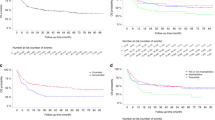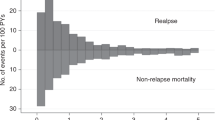Abstract
We report the results of non-myeloablative (NM) and myeloablative (MA) conditioning for haematopoietic cell transplantation in 207 consecutive AML patients at a single institution. A total of 122 patients were transplanted in first CR (CR1) and 67 in second CR (CR2). MA conditioning was given to 60 patients in CR1 and 50 in CR2. NM conditioning was given to 62 patients in CR1 and 17 patients in CR2. MA patients in CR1 experienced more acute GVHD than NM patients, 60.5% versus 22.9%, but the 5-year post transplant cumulative TRM was not different. Relapse incidence at 5 years in CR1 patients was 23.7% which is not statistically different from 28.5% in NM patients. Leukaemia-free survival at 5 years in CR1 patients was 57.7% after MA conditioning and 58.3% after NM conditioning. No statistical difference in overall 5-year survival after MA or NM conditioning was observed in CR1 patients (63.9 versus 64%) and CR2 patients (51.2 versus 64.7%). Durable remission can be obtained in older patients with AML in remission after NM conditioning, which may also be applicable to younger patients.
This is a preview of subscription content, access via your institution
Access options
Subscribe to this journal
Receive 12 print issues and online access
$259.00 per year
only $21.58 per issue
Buy this article
- Purchase on Springer Link
- Instant access to full article PDF
Prices may be subject to local taxes which are calculated during checkout





Similar content being viewed by others
References
Ringden O, Labopin M, Ehninger G, Niederwieser D, Olsson R, Basara N et al. Reduced intensity conditioning compared with myeloablative conditioning using unrelated donor transplants in patients with acute myeloid leukemia. J Clin Oncol 2009; 27: 4570–4577.
Luger SM, Ringden O, Zhang MJ, Perez WS, Bishop MR, Bornhauser M et al. Similar outcomes using myeloablative vs reduced-intensity allogeneic transplant preparative regimens for AML or MDS. Bone Marrow Transplant 2012; 47: 203–211.
Aoudjhane M, Labopin M, Gorin NC, Shimoni A, Ruutu T, Kolb HJ et al. Comparative outcome of reduced intensity and myeloablative conditioning regimen in HLA identical sibling allogeneic haematopoietic stem cell transplantation for patients older than 50 years of age with acute myeloblastic leukaemia: a retrospective survey from the Acute Leukemia Working Party (ALWP) of the European group for Blood and Marrow Transplantation (EBMT). Leukemia 2005; 19: 2304–2312.
Alyea EP, Kim HT, Ho V, Cutler C, DeAngelo DJ, Stone R et al. Impact of conditioning regimen intensity on outcome of allogeneic hematopoietic cell transplantation for advanced acute myelogenous leukemia and myelodysplastic syndrome. Biol Blood Marrow Transplant 2006; 12: 1047–1055.
Massenkeil G, Nagy M, Neuburger S, Tamm I, Lutz C, le CP et al. Survival after reduced-intensity conditioning is not inferior to standard high-dose conditioning before allogeneic haematopoietic cell transplantation in acute leukaemias. Bone Marrow Transplant 2005; 36: 683–689.
Scott BL, Sandmaier BM, Storer B, Maris MB, Sorror ML, Maloney DG et al. Myeloablative vs nonmyeloablative allogeneic transplantation for patients with myelodysplastic syndrome or acute myelogenous leukemia with multilineage dysplasia: a retrospective analysis. Leukemia 2006; 20: 128–135.
Shimoni A, Hardan I, Shem-Tov N, Yeshurun M, Yerushalmi R, Avigdor A et al. Allogeneic hematopoietic stem-cell transplantation in AML and MDS using myeloablative versus reduced-intensity conditioning: the role of dose intensity. Leukemia 2006; 20: 322–328.
McSweeney PA, Niederwieser D, Shizuru JA, Sandmaier BM, Molina AJ, Maloney DG et al. Hematopoietic cell transplantation in older patients with hematologic malignancies: replacing high-dose cytotoxic therapy with graft-versus-tumor effects. Blood 2001; 97: 3390–3400.
Grimwade D, Walker H, Oliver F, Wheatley K, Harrison C, Harrison G et al. The importance of diagnostic cytogenetics on outcome in AML: analysis of 1,612 patients entered into the MRC AML 10 trial. The Medical Research Council Adult and Children’s Leukaemia Working Parties. Blood 1998; 92: 2322–2333.
Lee SJ, Joffe S, Artz AS, Champlin RE, Davies SM, Jagasia M et al. Individual physician practice variation in hematopoietic cell transplantation. J Clin Oncol 2008; 26: 2162–2170.
Mielcarek M, Martin PJ, Leisenring W, Flowers ME, Maloney DG, Sandmaier BM et al. Graft-versus-host disease after nonmyeloablative versus conventional hematopoietic stem cell transplantation. Blood 2003; 102: 756–762.
Hill GR, Crawford JM, Cooke KR, Brinson YS, Pan L, Ferrara JL . Total body irradiation and acute graft-versus-host disease: the role of gastrointestinal damage and inflammatory cytokines. Blood 1997; 90: 3204–3213.
Uberti JP, Agovi MA, Tarima S, Haagenson M, Gandham S, Anasetti C et al. Comparative analysis of BU and CY versus CY and TBI in full intensity unrelated marrow donor transplantation for AML, CML and myelodysplasia. Bone Marrow Transplant 2011; 46: 34–43.
Bacigalupo A, Ballen K, Rizzo D, Giralt S, Lazarus H, Ho V et al. Defining the intensity of conditioning regimens: working definitions. Biol Blood Marrow Transplant 2009; 15: 1628–1633.
de Lima MJ, Anagnostopoulos A, Munsell M, Shahjahan M, Ueno N, Ippoliti C et al. Nonablative versus reduced-intensity conditioning regimens in the treatment of acute myeloid leukemia and high-risk myelodysplastic syndrome: dose is relevant for long-term disease control after allogeneic hematopoietic stem cell transplantation. Blood 2004; 104: 865–872.
Shimoni A, Hardan I, Shem-Tov N, Yerushalmi R, Nagler A . Allogeneic hematopoietic stem-cell transplantation in AML and MDS using myeloablative versus reduced-intensity conditioning: long-term follow-up. Leukemia 2010; 24: 1050–1052.
Passweg JR, Baldomero H, Gratwohl A, Bregni M, Cesaro S, Dreger P et al. The EBMT activity survey: 1990-2010. Bone Marrow Transplant 2012; 47: 906–923.
Kahl C, Storer BE, Sandmaier BM, Mielcarek M, Maris MB, Blume KG et al. Relapse risk in patients with malignant diseases given allogeneic hematopoietic cell transplantation after nonmyeloablative conditioning. Blood 2007; 110: 2744–2748.
Sorror ML, Storer BE, Sandmaier BM, Maris M, Shizuru J, Maziarz R et al. Five-year follow-up of patients with advanced chronic lymphocytic leukemia treated with allogeneic hematopoietic cell transplantation after nonmyeloablative conditioning. J Clin Oncol 2008; 26: 4912–4920.
Mortensen BK, Petersen SL, Kornblit B, Andersen PK, Braendstrup P, Andersen NS et al. Single-institution long-term outcomes for patients receiving nonmyeloablative conditioning hematopoeitic cell transplantation for chronic lymphocytic leukemia and follicular lymphoma. Eur J Haematol 2012; 89: 151–159.
Gyurkocza B, Storb R, Storer BE, Chauncey TR, Lange T, Shizuru JA et al. Nonmyeloablative allogeneic hematopoietic cell transplantation in patients with acute myeloid leukemia. J Clin Oncol 2010; 28: 2859–2867.
Popat U, de Lima MJ, Saliba RM, Anderlini P, Andersson BS, Alousi AM et al. Long-term outcome of reduced-intensity allogeneic hematopoietic SCT in patients with AML in CR. Bone Marrow Transplant 2012; 47: 212–216.
Giebel S, Labopin M, Mohty M, Mufti GJ, Niederwieser D, Cornelissen JJ et al. The impact of center experience on results of reduced intensity:allogeneic hematopoietic SCT for AML. An analysis from the Acute Leukemia Working Party of the EBMT. Bone Marrow Transplant 2013; 48: 238–242.
Lioure B, Bene MC, Pigneux A, Huynh A, Chevallier P, Fegueux N et al. Early matched sibling hematopoietic-cell transplantation for adult AML in first remission using an age-adapted strategy: long-term results of a prospective GOELAMS study. Blood 2012; 119: 2943–2948.
Bornhauser M, Kienast J, Trenschel R, Burchert A, Hegenbart U, Stadler M et al. Reduced-intensity conditioning versus standard conditioning before allogeneic haemopoietic cell transplantation in patients with acute myeloid leukaemia in first complete remission: a prospective, open-label randomised phase 3 trial. Lancet Oncol 2012; 13: 1035–1044.
Sorror ML, Giralt S, Sandmaier BM, de Lima M, Shahjahan M, Maloney DG et al. Hematopoietic cell transplantation specific comorbidity index as an outcome predictor for patients with acute myeloid leukemia in first remission: combined FHCRC and MDACC experiences. Blood 2007; 110: 4606–4613.
Acknowledgements
The excellent data management of Heidi Petersen and Camilla Roepstorff is greatly appreciated.
Author information
Authors and Affiliations
Corresponding author
Ethics declarations
Competing interests
The authors declare no conflict of interest.
Additional information
Supplementary Information accompanies this paper on Bone Marrow Transplantation website
Supplementary information
Rights and permissions
About this article
Cite this article
Sengeløv, H., Gerds, T., Brændstrup, P. et al. Long-term survival after allogeneic haematopoietic cell transplantation for AML in remission: single-centre results after TBI-based myeloablative and non-myeloablative conditioning. Bone Marrow Transplant 48, 1185–1191 (2013). https://doi.org/10.1038/bmt.2013.38
Received:
Revised:
Accepted:
Published:
Issue Date:
DOI: https://doi.org/10.1038/bmt.2013.38
Keywords
This article is cited by
-
Reduced BUCY 2 and G-CSF-primed bone marrow associates with low graft-versus-host-disease and transplant-related mortality in allogeneic HSCT
Annals of Hematology (2017)
-
The clinical utility of FDG PET/CT among solid organ transplant recipients suspected of malignancy or infection
European Journal of Nuclear Medicine and Molecular Imaging (2017)
-
Comparison of minimal residual disease as outcome predictor for AML patients in first complete remission undergoing myeloablative or nonmyeloablative allogeneic hematopoietic cell transplantation
Leukemia (2015)



